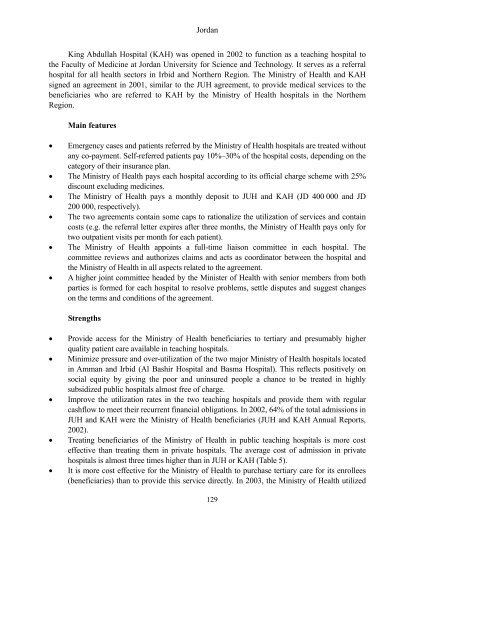The role of contractual arrangements in improving health sector ...
The role of contractual arrangements in improving health sector ...
The role of contractual arrangements in improving health sector ...
You also want an ePaper? Increase the reach of your titles
YUMPU automatically turns print PDFs into web optimized ePapers that Google loves.
Jordan<br />
K<strong>in</strong>g Abdullah Hospital (KAH) was opened <strong>in</strong> 2002 to function as a teach<strong>in</strong>g hospital to<br />
the Faculty <strong>of</strong> Medic<strong>in</strong>e at Jordan University for Science and Technology. It serves as a referral<br />
hospital for all <strong>health</strong> <strong>sector</strong>s <strong>in</strong> Irbid and Northern Region. <strong>The</strong> M<strong>in</strong>istry <strong>of</strong> Health and KAH<br />
signed an agreement <strong>in</strong> 2001, similar to the JUH agreement, to provide medical services to the<br />
beneficiaries who are referred to KAH by the M<strong>in</strong>istry <strong>of</strong> Health hospitals <strong>in</strong> the Northern<br />
Region.<br />
Ma<strong>in</strong> features<br />
• Emergency cases and patients referred by the M<strong>in</strong>istry <strong>of</strong> Health hospitals are treated without<br />
any co-payment. Self-referred patients pay 10%–30% <strong>of</strong> the hospital costs, depend<strong>in</strong>g on the<br />
category <strong>of</strong> their <strong>in</strong>surance plan.<br />
• <strong>The</strong> M<strong>in</strong>istry <strong>of</strong> Health pays each hospital accord<strong>in</strong>g to its <strong>of</strong>ficial charge scheme with 25%<br />
discount exclud<strong>in</strong>g medic<strong>in</strong>es.<br />
• <strong>The</strong> M<strong>in</strong>istry <strong>of</strong> Health pays a monthly deposit to JUH and KAH (JD 400 000 and JD<br />
200 000, respectively).<br />
• <strong>The</strong> two agreements conta<strong>in</strong> some caps to rationalize the utilization <strong>of</strong> services and conta<strong>in</strong><br />
costs (e.g. the referral letter expires after three months, the M<strong>in</strong>istry <strong>of</strong> Health pays only for<br />
two outpatient visits per month for each patient).<br />
• <strong>The</strong> M<strong>in</strong>istry <strong>of</strong> Health appo<strong>in</strong>ts a full-time liaison committee <strong>in</strong> each hospital. <strong>The</strong><br />
committee reviews and authorizes claims and acts as coord<strong>in</strong>ator between the hospital and<br />
the M<strong>in</strong>istry <strong>of</strong> Health <strong>in</strong> all aspects related to the agreement.<br />
• A higher jo<strong>in</strong>t committee headed by the M<strong>in</strong>ister <strong>of</strong> Health with senior members from both<br />
parties is formed for each hospital to resolve problems, settle disputes and suggest changes<br />
on the terms and conditions <strong>of</strong> the agreement.<br />
Strengths<br />
• Provide access for the M<strong>in</strong>istry <strong>of</strong> Health beneficiaries to tertiary and presumably higher<br />
quality patient care available <strong>in</strong> teach<strong>in</strong>g hospitals.<br />
• M<strong>in</strong>imize pressure and over-utilization <strong>of</strong> the two major M<strong>in</strong>istry <strong>of</strong> Health hospitals located<br />
<strong>in</strong> Amman and Irbid (Al Bashir Hospital and Basma Hospital). This reflects positively on<br />
social equity by giv<strong>in</strong>g the poor and un<strong>in</strong>sured people a chance to be treated <strong>in</strong> highly<br />
subsidized public hospitals almost free <strong>of</strong> charge.<br />
• Improve the utilization rates <strong>in</strong> the two teach<strong>in</strong>g hospitals and provide them with regular<br />
cashflow to meet their recurrent f<strong>in</strong>ancial obligations. In 2002, 64% <strong>of</strong> the total admissions <strong>in</strong><br />
JUH and KAH were the M<strong>in</strong>istry <strong>of</strong> Health beneficiaries (JUH and KAH Annual Reports,<br />
2002).<br />
• Treat<strong>in</strong>g beneficiaries <strong>of</strong> the M<strong>in</strong>istry <strong>of</strong> Health <strong>in</strong> public teach<strong>in</strong>g hospitals is more cost<br />
effective than treat<strong>in</strong>g them <strong>in</strong> private hospitals. <strong>The</strong> average cost <strong>of</strong> admission <strong>in</strong> private<br />
hospitals is almost three times higher than <strong>in</strong> JUH or KAH (Table 5).<br />
• It is more cost effective for the M<strong>in</strong>istry <strong>of</strong> Health to purchase tertiary care for its enrollees<br />
(beneficiaries) than to provide this service directly. In 2003, the M<strong>in</strong>istry <strong>of</strong> Health utilized<br />
129
















